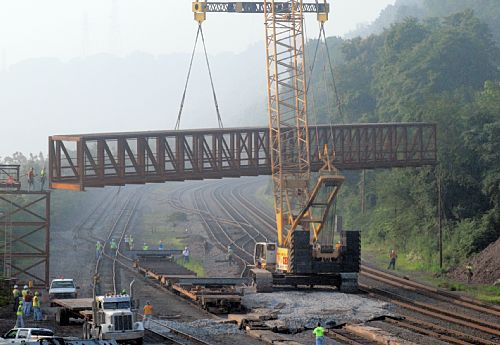
County Bridges All Gaps But One in Pittsburgh-to-D.C. Trail: Onorato Wants it Completed by 2011

The 62-ton bridge across railroad tracks is lifted into place in Whitaker on Wednesday. Darrell Sapp/Post-Gazette
Construction cranes on Wednesday eliminated two of the biggest obstacles to completing a 335-mile biking and hiking trail from Pittsburgh to Washington, D.C., a project that has been in the works for 35 years.
Crews hoisted prefabricated bridges over active freight rail lines in Whitaker and Duquesne along the Monongahela River. Construction of a 21/2-mile trail segment linking the bridges to the existing trail will begin by fall, with completion expected by January, said Jack Paulik, project manager for Regional Trail Corp.
“This is a major milestone,” Mr. Paulik said.
All that will remain incomplete on the Great Allegheny Passage after that is a one-mile stretch through Sandcastle Waterpark. Negotiations with the park owners have not produced an agreement that will allow the trail to go through.
“There’s no solution just yet,” Allegheny County spokesman Kevin Evanto said. “We’re kind of at the same place we were a couple months ago.”
County Executive Dan Onorato has established a goal of completing the trail by “11-11-11” — Nov. 11, 2011. Mr. Evanto said the goal is reachable.
A 170-foot-long, 62-ton bridge erected in Whitaker crosses six sets of tracks operated by Norfolk Southern Railway and Union Railroad Co. A 110-foot-long, 37-ton bridge in the RIDC industrial park in Duquesne crosses three sets of Norfolk Southern tracks.

The 62-ton bridge across railroad tracks is lifted into place in Whitaker on Wednesday. Darrell Sapp/Post-Gazette
The bridges will provide “a spectacular view of the river, the working river,” Mr. Paulik said.
Pushing the trail through the former industrial sites and over the rail lines ranks near the top of the development feats on the trail project, he said, along with renovation of the 3,291-foot Big Savage Tunnel in Somerset County that was completed in 2006.
The two bridges erected on Wednesday are about 2 miles apart and will be connected with a trail along U.S. Steel’s former coke gas pipeline, which the company donated in 2007. The segment will hug the hillside between Route 837 and the river, connecting to McKeesport to the south and The Waterfront complex to the north.
A $500,000 state grant helped to fund the bridges, with private money paying the rest of the $950,000 cost, Mr. Paulik said. Developing the piers and substructure cost $2.5 million, nearly all of which was private donations, he said.
The bridges will enable trail users to avoid Route 837, which is dangerous for bicycling.
Development of the 150-mile Great Allegheny Passage, which connects at Cumberland, Md., with the C&O Towpath to Washington, began in 1975 with the abandonment of 87 miles of railroad line from Cumberland to Connellsville.
Nine years later, the first 9.5 miles of trail opened in Ohiopyle State Park.
